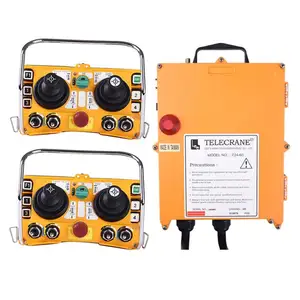Types of ce remote controllers
CE remote controllers come in various types suitable for controlling different kinds of consumer electronics. The most common types include;
- Universal remote controllers: They are applicable for most CE remote controllers. They are designed to replace multiple remote controllers by learning the codes from different devices. They can be used to control TVs, DVD players, audio systems, and other consumer electronics with a single remote. Depending on the model, some universal remote controllers may require manual programming, while others offer an easy programming process using infrared (IR) or radiofrequency (RF) technology to learn the code.
- Infrared remote controllers: Many CE remote controllers use IR technology to send control signals to devices. The remote controller has an IR transmitter, which is a light-emitting diode (LED) that sends a pulse of infrared light at a specific frequency. The device being controlled has an IR receiver that detects the signal and responds accordingly. With line-of-sight between the remote and the device, the IR signal moves. Although most TVs, sound systems, and other consumer electronics come with IR remote controllers, the ancient technology has limitations. It includes the need for direct sight and the inability to work over long ranges.
- Radio frequency remote controllers: Unlike infrared remote controllers, RF remote controllers use radio frequency to control devices. The remote controller has an RF transmitter that sends control signals to an RF receiver, which is mostly built into the device being controlled. CE remote controllers can use various RF technologies, including Bluetooth and Zigbee. When looking for remote controllers for consumer electronics that can work over long ranges and don’t require line-of-sight, RF remote controllers are the best option.
- Bluetooth remote controllers: Similar to RF remote controllers, Bluetooth remote controllers use Bluetooth technology to control devices. The main difference between RF and Bluetooth remote controllers is that the former works with any RF technology, while the latter works with specific Bluetooth technology. Bluetooth remote controllers are applicable for controlling TVs, streaming devices, and Bluetooth-enabled audio systems.
- Smart remote controllers: Smart remote controllers offer advanced features and functionality. They often come with touch screens, voice control, and integrated smart assistants. Depending on the device, smart remote controllers can be based on infrared, radio frequency, or Bluetooth technology.
Functions and Features
Applications of CE remote controllers include machines, transport, home amusements, advanced hardware, and huge devices.
Functions of CE Remote Controllers
- Control: CE remote controllers manage the on and off status of a device. They switch gadgets, for example, TVs, sound frameworks, and review hardware on or off as it were.
- Channel selection: Some remotes have a directional pad or channel catch to move between channel spaces straightforwardly.
- Volume control: most CE remotes have volume control catches to change the loudness of the sound result from the managed gadget. Clients can increment or abatement the volume with the devoted dialer.
- Playback control: Many distant regulators have playback control, which comprises of stops, rewind choices, quick advance, and duplicate catches. These controls permit clients to survey indistinguishable commitments from they desire and replay or edit them according to the remote control ruin.
- Tuner control: on occasion, the tuner control is incorporated, which assists with managing the recurrence or channel of a radio or TV. It tends to be a dial or a progression of catches that address explicit recurrence or channel numbers.
- Power control: many CE distant regulators incorporate power control abilities, permitting clients to switch gadgets on or off from a distance. This capability further develops accommodation and energy proficiency, keeping up with ideal gadget status.
- Numerical keypad: Some CE distant regulators have a numerical keypad to enter numbers or codes straightforwardly. The numerical keypad has a total set of numbers and different images and probably a range of letters to facilitate material input.
- Colored buttons: Some distant regulators have hued buttons used for explicit capabilities or easy routes. Their motivation might differ by gadget or producer, yet they are typically planned with this helpful instrument for the speedy execution of various pursuits.
Furthermore, CE remote controllers offer a variety of distinctive characteristics that provide versatile operating methods and user experience. They now have an expanded control range, which is the furthest distance the controller can reach from the gadget without breaking the signal. It usually ranges from hundreds of meters to several kilometers.
The flexibility in response to the type of signal it receives is another obvious characteristic, wherein infrared remote controllers provide a great advantage in different instances, despite the fact that radio frequency and Bluetooth signal controllers are more reliable and efficient. All three presented together have the advantage of being cost-efficient since they only require the equipment to be manufactured and the technology to be integrated into the gadget.
Then there is the multi-device control feature, which allows controlling many gadgets with one remote controller. Dedicated controllers are typically used for more complex and specialized tasks, as in the case of industrial remote controllers. However, general ones, which are usually supplied with consumer electronics, are preferred.
In terms of complexity, one can find CE remote controllers varying from simple to smart, i.e., with simple controls and screens or sophisticated ones with voice assistants and virtual interfaces.
Applications of CE Remote Controllers
The CE remote controller has many uses. This versatility makes it popular across different industries.
-
Consumers Electronics
The most common use for remote controllers is in consumer electronics. Here, they control TVs, audio systems, DVD players, and gaming consoles, among other devices. The controller lets users adjust settings, change channels, control playback and access different functions from a distance.
-
Automotive Industry
Automakers also use remote controllers in vehicles. They control functions such as keyless entry, theft alarms and remote engine start. Moreover, steering wheel remotes for car audio systems and hands-free calling give drivers safe and easy operation.
-
Industrial Applications
Manufacturing plants use remote controllers to operate industrial machines. These include cranes, forklifts, conveyors and robotic arms. The remote allows the operator to control machine movement from a safe distance. It also enhances efficiency in tight spaces.
-
Aviation Industry
Pilot remote controllers help to operate aircraft systems — such as autopilot, thrust reversal and landing gear. Drones and remote-operated aircraft use remote controllers for flight commands. The controller design for drones has additional functions for navigation, camera control and telemetry data.
-
Medical Equipment
Surgeons use remote controllers to operate robotic-assisted systems for minimally invasive surgery. Radiology and laboratory technicians use remote controllers for diagnostic imaging machines and automated testing systems. Wheelchair remote controllers allow patients with limited mobility to operate the wheelchair.
-
Smart Home
Users control smart home devices such as lights, thermostats, locks and cameras from a central remote controller. Smart controllers with built-in voice assistants allow seamless interaction with smart home systems.
-
Security Systems
Security systems use dedicated remote controllers to operate alarms, surveillance cameras and motion sensors. Some controllers allow users to arm or disarm the security system and control camera pan-tilt options.
-
Outdoor Equipment
Outdoor equipment such as drones, boats, ATVs, and snowmobiles use remote controllers for operation. These controllers offer a simple platform to give commands for movement, speed, and other functions.
How to Choose CE Remote Controllers
Commercial buyers should learn more about end users before buying items in bulk. Users' preferences may influence the choice of RF remote controllers. Collecting information about the market can help make better decisions. Follow the steps below when choosing custom remote controllers for customers.
- Know the Purpose: The first step is to find out what the remote controller will be used for. Different jobs need different kinds of remote controllers. Knowing what it will be used for will help narrow down the choices.
- Look at the Range: The range is how far the remote can work. If it is for use inside a small room, a short-range remote will be fine. But if the remote needs to work over a long distance, like in a big factory, then a long-range remote is needed. Consider where the remote will be used most.
- Consider Environment Factors: Environment factors are things like weather, temperature, and presence of dust or moisture. Tough remotes that can handle bad weather are needed if the remote will be used outside. For dusty places, look for remotes with a filter to clean the air inside the remote.
- Find the Right Frequency: The frequency is how the remote sends signals to the devices. Different devices work well with different frequencies. Find out what device will be controlled by the remote and choose a frequency that works with that device.
- Think About Handset Controls: The controls on the handset are what users need to think carefully about. The controls should be easy and comfortable for users to work. If users are old, they may need big buttons. For workers in a hurry, custom controllers with push and hold buttons will work best.
- Get Extra Features If Needed: Extra features can make working easier or more difficult. The following points can help to decide if extras are needed.
- Will the remote need to know who is using it? Use the remote controller with a unique ID number for this.
- Do users need to talk to the remote? Voice-mandated remotes with voice commands will be great.
- Would users like to use their smartphone as a remote? Look for wireless remotes that allow users to use their smartphones as a remote controller.
- Settle for the Right Price: Bulk ce remote controller purchases will attract discounts from suppliers. Estimate the number to be used in a given period. Choose a remote controller that will provide a good return on investment based on features, cost, and durability.
- Get Reliable Suppliers: Suppliers should have a good reputation and provide reliable after-sale services. Review ratings and feedback from previous buyers. Make inquiries to test the responsiveness of the supplier's support team.
Q&A
Q: Can the CE remote controller be customized for specific branding?
A: Yes, customization options are available to tailor the CE remote controller to specific branding and requirements.
Q: What are the maintenance requirements for CE remote controllers?
A: Maintenance needs may vary based on controller type. Generally, routine upkeep includes checking connectivity, cleaning, and replacing batteries.
Q: Can spare parts be obtained for remote controllers?
A: Yes, suppliers offer spare parts for remote controllers to facilitate repairs and ensure long-term usage.
Q: What are the battery types used in remote controllers?
A: Various battery types are used in remote controllers, including alkaline, rechargeable lithium-ion, and specialized batteries.
Q: What measures are in place to ensure product quality and reliability?
A: Quality assurance measures, including testing protocols and certifications, are implemented to uphold the quality and dependability of CE remote controllers.

















































































































































































































